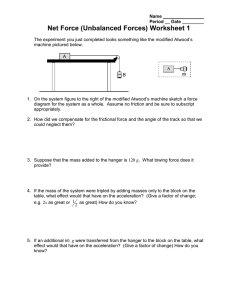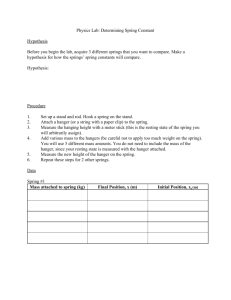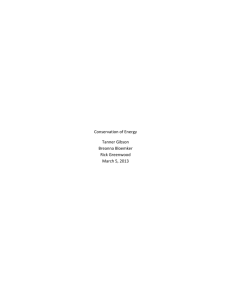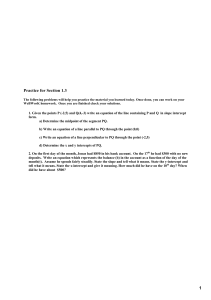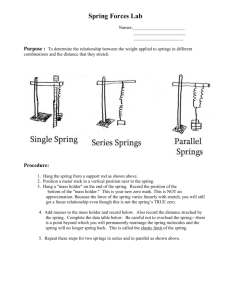250 13-1 EXPERIMENT 13
advertisement
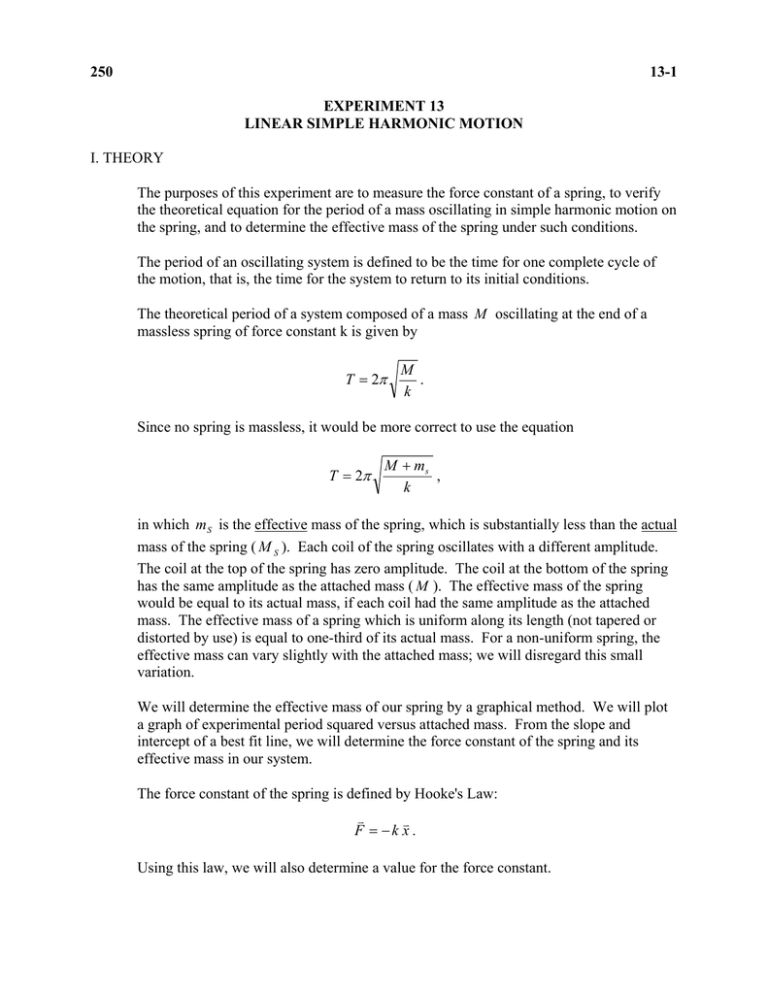
250 13-1 EXPERIMENT 13 LINEAR SIMPLE HARMONIC MOTION I. THEORY The purposes of this experiment are to measure the force constant of a spring, to verify the theoretical equation for the period of a mass oscillating in simple harmonic motion on the spring, and to determine the effective mass of the spring under such conditions. The period of an oscillating system is defined to be the time for one complete cycle of the motion, that is, the time for the system to return to its initial conditions. The theoretical period of a system composed of a mass M oscillating at the end of a massless spring of force constant k is given by T = 2π M . k Since no spring is massless, it would be more correct to use the equation T = 2π M + ms , k in which m S is the effective mass of the spring, which is substantially less than the actual mass of the spring ( M S ). Each coil of the spring oscillates with a different amplitude. The coil at the top of the spring has zero amplitude. The coil at the bottom of the spring has the same amplitude as the attached mass ( M ). The effective mass of the spring would be equal to its actual mass, if each coil had the same amplitude as the attached mass. The effective mass of a spring which is uniform along its length (not tapered or distorted by use) is equal to one-third of its actual mass. For a non-uniform spring, the effective mass can vary slightly with the attached mass; we will disregard this small variation. We will determine the effective mass of our spring by a graphical method. We will plot a graph of experimental period squared versus attached mass. From the slope and intercept of a best fit line, we will determine the force constant of the spring and its effective mass in our system. The force constant of the spring is defined by Hooke's Law: v v F = −k x . Using this law, we will also determine a value for the force constant. 250 13-2 II. LABORATORY PROCEDURE 1. Suspend the spring (small end up for all parts of the lab) using the bar attached to the table clamp, the right-angle clamp and the threaded bar. Hanging the spring at the threaded end will keep it from sliding during the experiment. Attach a weight hanger to the spring. 2. Using a 1-meter or 2-meter stick and a caliper jaw measure the height of the bottom of the weight hanger above the laboratory floor. Record the reading and a mass of 50 g in a table. 3. Add 50 g to the weight hanger. Measure the height of the bottom of the weight hanger above the floor. Record the height and the mass in your table. 4. Repeat step 3 until a total of 350 g has been added to the weight hanger. 5. Place 50 g on the 50 g weight hanger. Make a table containing three columns: attached mass, time for 50 oscillations-first run, and second run. Record the attached mass as 100 g. Raise the mass a few centimeters above equilibrium, and release it. If the amplitude is too large, the motion tends to be unstable. If the mass is not oscillating up and down along a straight line, start the mass again. Start the stopwatch as the mass reaches either extreme position. Stop the stopwatch after 50 complete oscillations. (One complete oscillation brings the mass back to the extreme position from which is started.) Record the elapsed time in your table. Carry out the second run in the same way, having a different student do the timing. If the times for your two runs differ by more than half a second, carry out two additional runs. If these runs differ by more than half a second, inform your instructor. 6. Repeat step 5 for total masses of 200, 300, and 400 grams. 7. With a balance, measure the actual mass of the spring. 8. OPTIONAL: If time permits, repeat steps 1-4 using two springs in parallel. To have the springs in parallel, hang both from the horizontal rod. To the bottom of each, attach the wooden piece, and to the wooden piece attach the weight hanger. 9. OPTIONAL: If time permits, repeat steps 1-4 using two springs in series, but stop once the mass added to the weight hanger reaches 250g. To have the springs in series, hang one from the horizontal rod. To the bottom of the first, attach the other spring, and to it the weight hanger. 10. Before returning your equipment, put the weight sets in order: 500, 2-200, 100, 50, 2-20, and 10 g. 250 13-3 III. CALCULATIONS AND ANALYSIS 1. Use the Method of Differences to calculate the average change in length of the spring corresponding to a change in load of 50 grams. If you have forgotten the Method of Differences, it is in the Introduction of the Lab Manual. 2. Using the previous result and Hooke's Law, calculate the force constant of the spring. 3. Calculate the experimental period for each mass used in Procedural Steps 5 and 6 using the average time of your two runs. 4. Make a table of the quantities attached mass, period, and period squared. 5. Plot a graph of period squared versus attached mass. Draw the straight line that best fits the plotted points. Estimate the intercept on the mass axis. What quantity does the negative of the intercept represent? 6. Calculate the slope and the period squared intercept of the Least Squares Line by applying the Method of Least Squares. Make a table as in the Introduction of the Lab Manual, using all four data points. Note the warning relating to rounding errors on that page. 7. Derive a formula relating the slope of your graph to the force constant. Use this formula, along with the slope from Step 6, to calculate a second value of the force constant. Find the percent difference between this value and the value found in step 2. 8. From the values found in the Step 6, calculate the mass intercept and the effective mass of the spring. Calculate the percent difference between this value for the mass intercept and the estimate from Step 5. 9. Using the result of Step 8, calculate the ratio of the effective mass to the actual mass of the spring. Find the percent difference between this value and the value for a uniform spring (one-third). 10. If you performed the optional Procedural Step 8, repeat Calculations 1 and 2 for the data with two springs in parallel to find the equivalent force constant of the two springs. How does the equivalent force constant relate to the force constant of the single spring? 11. If you performed the optional procedural Step 9, repeat Step 11 for the springs in series.
